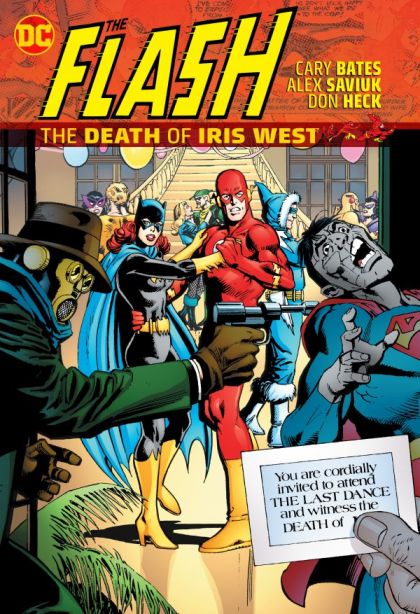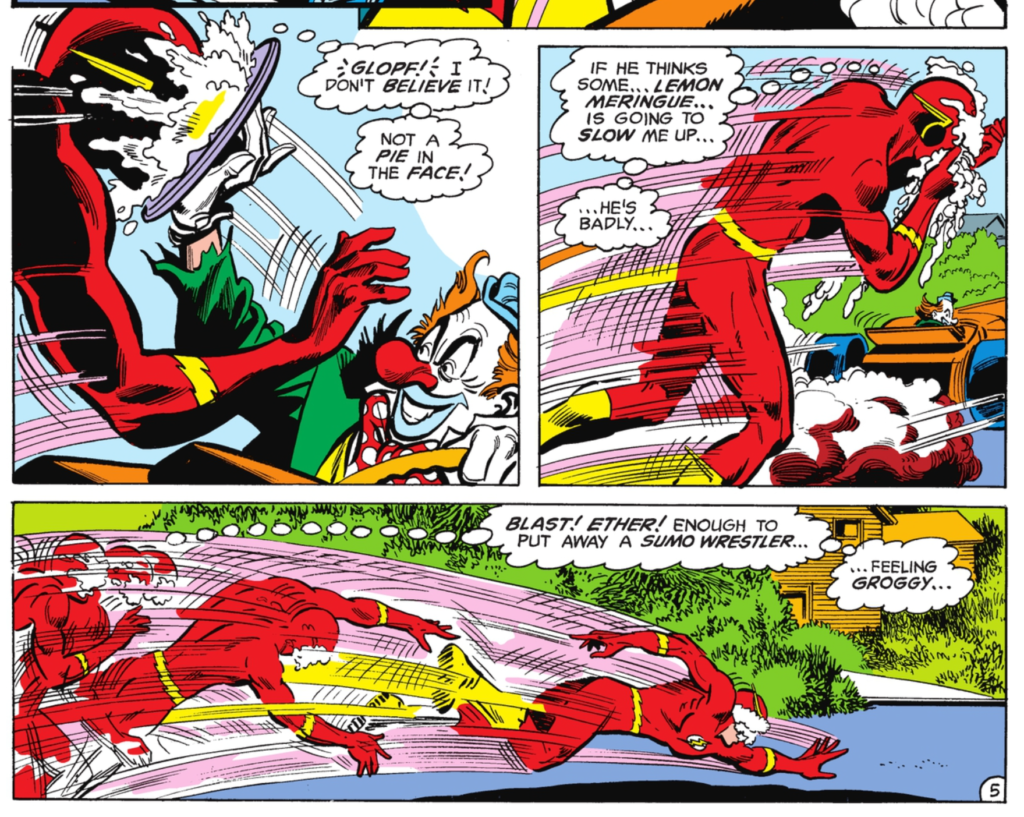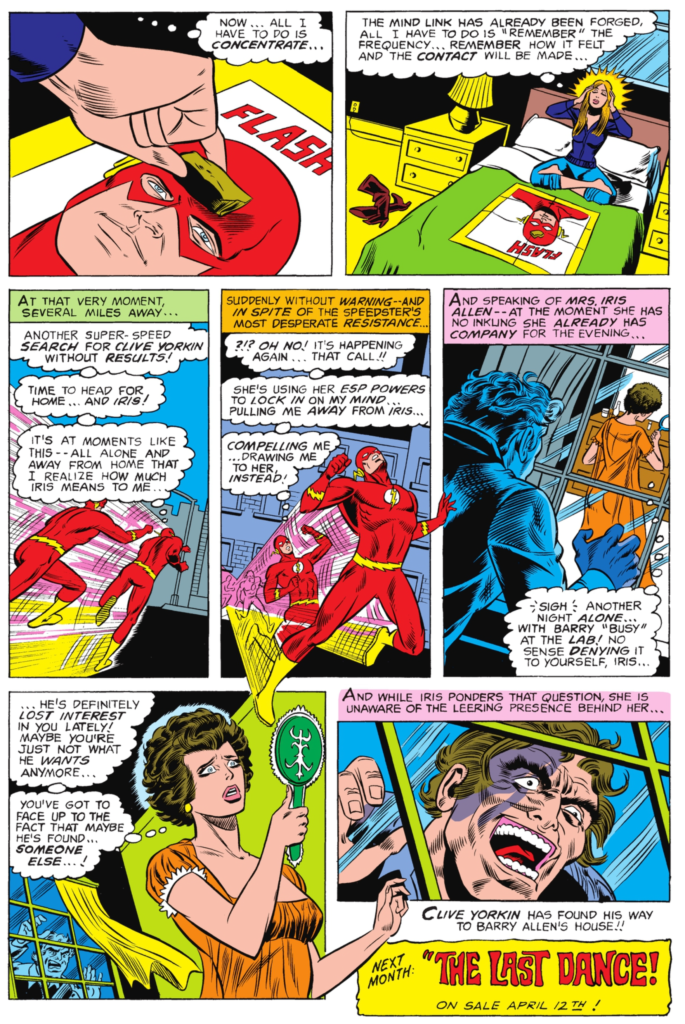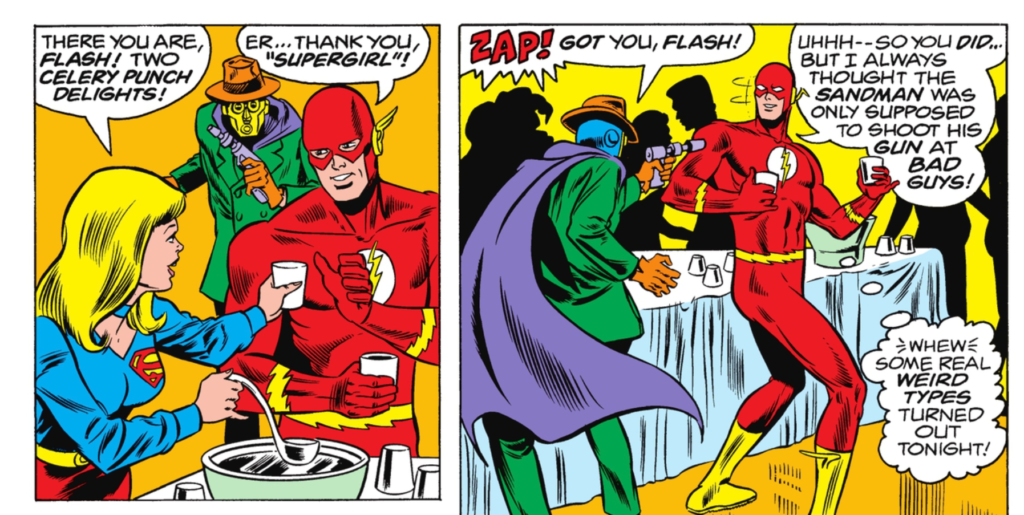Unbagging The Flash: The Death Of Iris West
The Flash: The Death Of Iris West

Release: Jun 01, 2021
Cover: 2021

Can the Fastest Man Alive outrun his worst nightmare? The Flash can’t outrun the loss of his wife, but nothing will stop him from hunting down her killer. Follow along as Barry Allen races to find out who is responsible for the death of his wife, Iris…and hold them responsible. This title collects stories from The Flash #270-284.
Creators
| Writer | Cary Bates |
| Artist | Alex Saviuk | Irv Novick | Don Heck | Rich Buckler |
| Cover Artist | Dick Giordano |
Cut the formalities, Superman–we’re talking about Iris…someone we all knew…someone I loved like a sister!
For a variety of reasons, I’m not going to be heading to the theater to see The Flash, but even so, I thought I should take the opportunity to pull this hardcover off the to-be-read pile and to-be-read it.
Back before Barry Allen died and then returned and they decided to give him a tragic backstory, this storyline had been the defining tragedy in the Scarlet Speedster’s life.
In reading this collection, I was surprised to see how much of it was familiar. I hadn’t realized that I’d read so much of it – via mystery packs – back then, but it turns out I had read most of it, with the exception of some of the issues that led up to the main event. (As you’ll see, I wasn’t missing anything.)
Of course, I probably got them out of order – I seem to recall having read the issue in which the killer is revealed before reading the issue in which the murder happens – and “back then” would have been anywhere from four months to a year after their release. Certainly, I recall seeing that cover image – the cover of #275 – in a house ad a long time before I read the actual story.
Obviously, I very much wanted to read that story based on that cover. I mean, Bizarro apparently being killed by the Sandman? What? And why is Flash dancing with Batgirl?
Of course, none of that happens in the comic – except for the Flash dancing with Batgirl part – but let’s not get ahead of ourselves.
The beginning of this epic focuses on Barry (Flash) Allen kind of having a rough go of it. He’s been distracted at work and making careless errors – though given that he works in police forensics and what we keep learning about how unreliable most forensic science is, that seems like par for the course – things aren’t going great at home because despite being the fastest man alive, he’s always late, much to his wife’s chagrin, and as the Flash he keeps getting his ass handed to him by some clown.
No, really. A clown. Not the Joker, either just some random schmuck dressed like a clown.

We spend multiple issues with Flash continually losing to some random guy dressed like a clown who has some tricked-out circus-themed weapons and vehicles, and honestly, it’s embarrassing.

I guess if nothing else it demonstrates how a guy called Captain Boomerang can pose a deadly threat to a guy who can move at the speed of light.
Ultimately, the clown is revealed to be a former circus performer who’s out for revenge for…you know what? It doesn’t matter. The whole clown thing is just the absolute worst part of this and it’s utterly meaningless.
Other things that are happening:
- A teenage girl with psychic powers has a crush on the Flash
- Back at Barry’s precinct, some dirty cops are stealing heroin from the evidence locker
- Barry is involved in a rehabilitation program of dubious ethics
- Iris thinks that having a baby will solve their marriage woes
The added responsibility of evaluating “The Nephron Process,” an experiment in rehabilitating criminals based on some research Barry had done in college, which involves spending time at the state penitentiary after-hours, puts a further strain on his relationship with Iris (Which ultimately leads her to get a new hairdo in the hopes of spicing things up and getting things back on track, because that’s the kind of thing a dame would do, right fellas? And when that fizzles, she latches onto the baby idea. Because everyone knows that having a kid is the best way to save a failing marriage.)
Anyway, the Nephron Process is basically the treatment from A Clockwork Orange. A convict named Clive Yorkin volunteers, and he’s hooked up to a chair where he’s shown images of negative behavior and images of positive behavior. Whenever he’s shown the negative, he gets a painful jolt of electricity. Whenever he’s shown something positive, he gets a pleasant jolt of electricity directly to his brain’s pleasure center.
After seeing it in action a few times, Barry has misgivings, and reports to his boss that he cannot endorse the Nephron Process. Nephron, however, continues on without Barry’s assistance.
Since Barry is free from working on that extra project, the chief pairs him up with an undercover cop who is looking into the police heroin smuggling ring. Barry had initially discovered the scheme, as his lab was being used as part of it. They were taking the heroin out of storage and hiding it in Barry’s lab disguised as his lab supplies. At night, someone would sneak in, take the fake supplies, and replace them with the real supplies.
However, they didn’t consider that at some point Barry and his assistant would actually use the supplies, and when they do, Barry discovers that rather than silver nitrate he’s using pure, uncut heroin. He sets up a silent alarm to alert him to anyone coming into his lab, and when it goes off and he comes in to check on it, the heroin is gone, and his supplies are back.
Anyway, this all leads to Barry forming a fast friendship with Detective Frank Curtis, and the two bond after nearly being killed in the course of their investigation.
But this is actually out of order, as before any of that, Barry, as the Flash, has to help quell a riot at the state penitentiary, where he finds an insane Clive Yorkin sitting in the chair willingly zapping himself with the pain button. Somehow, in addition to turning him into a drooling maniac, the Nephron Process gave Yorkin superhuman strength and the ability to match the Flash’s vibrational frequency, which means that once he gets his hands on him, Flash isn’t easily able to escape.
Yorkin, however, does escape, after strapping Dr. Nephron into the chair and hitting him with pain and pleasure simultaneously. Flash sets him free, but it’s too late, as Dr. Nephron is now a vegetable.
Oh, also, the psychic teen used her powers to summon the Flash, who was unable to resist, and complied against his will. Unfortunately, some dogs interrupted before she could accomplish whatever it was she wanted to accomplish.
The main thing we know about said girl at this point is that she has powers and that she has no interest in any ordinary guy. Even John Travolta is too ordinary for her liking!
Anyway, despite getting things out of order, we’re close to the main event now.
The psychic girl – Melanie – is once again summoning the Flash to her, even as the escaped Yorkin has located Barry Allen’s home.

Melanie summons Flash to her motel room. Iris, meanwhile, reveals that she’s planted a tracking device on Barry, and she’s using it to find out where he is.
Once Melanie has Barry under her power, she forces him to remove his mask so she can finally get a proper look at this extraordinary man who has captured her imagination.
Unfortunately, he turns out to be just as ordinary as a common John Travolta.

Melanie leaves in a huff and a bewildered Barry is greeted by Iris arriving in a huff, having seen Melanie leaving the room and assumed the worst.
Iris takes off and gets in a car accident that results in a fiery explosion. Barry saves her – and the two people the explosion would have killed – then just takes her home and they just ignore the whole thing where Iris destroyed their car and a semi and nearly killed two people and hope that it will just go away. (It does. There are literally no consequences.)
As he’s running her home, Barry convinces Iris that he wasn’t cheating on her, and then she springs the baby idea, and then they get ready to go to a charity masquerade party.
Meanwhile, a shadowy figure makes a phone call informing the person on the other end that Barry will be at said party and that Barry must not make it out alive.
Barry was supposed to dress up as Batman, with Iris as Batgirl – the theme is “come as your favorite super character” – but there was a mix-up at the costume shop, so Barry has no costume. Iris provides the obvious solution: just wear your actual costume.
Frank Curtis is accompanying the Allens to the party, and he shows up also dressed as the Flash.
At the party, Barry gets a phone call from the chief who apparently called for no other reason than to tell him that he wasn’t calling him for any reason and that they’ll talk tomorrow.
Frank steps outside for a smoke and gets attacked by Clive Yorkin, who’d followed them to the party, but Yorkin loses interest after tearing off Frank’s mask and seeing that he’s not Barry.
Barry stops to get some punch, and gets zapped by the Sandman, which never made any sense to me.

Not for the reason Barry mentions, but because Sandman was a resident of Earth-Two, whereas this story takes place on Earth-One. I suppose people might be familiar with him from a JLA/JSA crossover, or maybe, like Barry’s Earth-Two counterpart, Jay Garrick, there were comics featuring the Sandman’s adventures published on Earth-One. Still, it just struck me as odd.
Anyway, upon returning to Iris, Barry finds her dancing with the real Green Lantern who happened to be in the neighborhood and couldn’t resist the opportunity to crash the party.
Barry and Iris decide to scope out the mansion, but as they’re heading up the stairs, Barry gets dizzy and needs to sit down for a bit. Iris heads to get him a glass of water, but then Barry hears a loud noise and Iris crying his name. He groggily makes his way to the restroom where he finds Iris lying on the floor and Yorkin standing over her.
Before Barry can react, Yorkin jumps out the window. Barry tries to pick Iris up to get her some help, but he collapses as other guests arrive to investigate the noise.
Frank comes in and asks the “Batman” who’s tending to them how they’re doing, and we learn that one of them needs to get to a hospital, and the other is dead.
Given the title of this hardcover volume, it’s not exactly a spoiler for this story from 1979 to reveal that it is, in fact, Iris who’s dead.
And that’s where I’ll leave the in-depth retelling of the events of each issue and focus on some things that really stood out for me in the issues that followed, because a lot if it just weird and there are a lot of “That’s now how this works, that’s not how any of this works” moments.
The thing that really stands out is how little focus there is on Barry’s grief. It’s mentioned every so often, but there aren’t really any quiet moments in which Barry sits with his grief. That might make sense, if handled better; that is, the Fastest Man Alive is not going to spend a lot of time standing still, and as a crimefighter in both of his jobs, it would seem to follow that he would throw himself into his work.
And that’s mostly what he does, working to track down his wife’s killer in both of his identities, but the presentation of it is off. It seems less like dealing with his grief by throwing himself into his work and more like just carrying on with business as usual. Not acting as if nothing happened to protect his emotions, but acting as if the thing that happened isn’t really that important.
The majority of the emotional fallout is dealt with in the two issues that immediately follow the death. Barry comes to in a hospital, not knowing that Iris is dead, acts up a bit, gets sedated a lot, has bad dreams about recent events, and then, after five days, Frank shows up to take him home. It’s only at that point that he’s finally informed that Iris has died. The reason he was in the hospital is that someone had dosed him with Angel Dust the night Iris died (which is why he was dizzy right before Iris was attacked).
Then he beams up to the Justice League satellite, demands that either Superman, Wonder Woman, or Green Lantern do something to bring Iris back to life, then goes on a rampage when they say they won’t/can’t. The Leaguers determine that it’s the result of the drugs that were in his system.
Then we get a page and a half for Iris’s funeral, everyone talks about what a survivor Barry is and how much class he has, and that’s more or less it for the grieving.
Barry, however, has decided to give up on being the Flash and gives a tip to the press about an announcement he’ll make at the Flash Museum, making it obvious that he’s planning to announce his retirement. Melanie reads about that in the paper, and having also read about Iris dying, she feels bad about telling him he’s ordinary, so she tracks him down and convinces him not to retire.
Melanie helps out a bit more as Barry tries to track down Yorkin, who has gained the ability to feed on fear, leaving a trail of victims in his wake, victims he’s literally scared to death.
Oh, and part of the reason that Yorkin got so messed up by the Nephron Process is that he’s dyslexic. So when he was being shown negative imagery and was supposed to be feeling pain, he was feeling pleasure, and the pain came with the positive images. Because, sure, that’s how dyslexia works, right?
The most significant references to Iris as something other than a victim whose murder Barry is trying to solve/avenge come in his encounters with Yorkin, as Barry learns that thinking about his love for Iris not only protects him from Yorkin’s fear powers, it actually repulses Yorkin.
Yorkin eventually dies, after some filler issues that have appearances from some members of the Flash Rogues Gallery, and it turns out that Yorkin was a red herring anyway, as some invisible fiend was the one who really killed Iris.
Also, Barry got dosed with the Angel Dust at the party when he got “zapped” by the Sandman.
The whole heroin plot is connected to Iris’s murder, as the killer was the big boss behind the operation, having recruited the Chief himself to be the inside man at the precinct. (That “I just called to say I love you” phone call was really just to make sure that Barry was at the party and available to be dosed.)
Anyway, eventually, Barry figures out who the killer is and there is seemingly some kind of justice delivered by the end of the story arc.
I won’t spoil the identity of the killer, but if you’re at all familiar with the current continuity and the tragic murder in Barry’s past, you probably have some idea of who it is.
(It was the Reverse Flash)
The shole thing ends with Barry taking a literal trip down memory lane and pausing to visit his wife’s grave.
There was a lot more besides – again, the thing with the clown went on for multiple issues– with all sorts of convoluted twists and turns, but that was the main story of the death of Iris West Allen.
Obviously, the death of his wife would, despite his limited grieving, have a huge impact on the Flash for years to come, ultimately setting up the end of his series and his death in Crisis on Infinite Earths.
So I’m surprised to see, upon revisiting it, just how lackluster it was, and how even though there was so much going on, not a whole lot seemed to happen. Really, there was just too much happening, so no one sub-plot got enough attention, and none of it tied together in a particularly pleasing way.
It was just stuff happening for the sake of having stuff happen, and while a lot of it was pretty wild – Corrupt cops selling confiscated drugs! Immoral experiments performed on prisoners! Murder! – it wasn’t presented with much coherence, depth, or verisimilitude.
I mean, Barry didn’t even take any time off from work, and no one even gave lip service objections to him investigating his wife’s murder. (At least the JLA gave him a leave of absence, though I was annoyed with how smug they seemed to be about it. Like, “Look how nice and thoughtful we are! We’re giving Barry some time off. We’re so magnanimous!”)
And then there’s Iris, who, despite being at the center of this collection of stories and in the title, didn’t really do much other than die. I think we spent more time with Melanie than we did with her. And when we did spend time with her, she was alternating between being mad at Barry and desperately wanting his attention. So much of what we see is just a bunch of sexist tropes, and her characterization feels regressive even by Bronze Age standards.
Is her death an example of a fridging? In some ways, yes, but in others, no, because despite what is sometimes claimed, her death doesn’t really seem to have that much of an impact on Barry’s development. But her death really doesn’t serve a greater narrative purpose either, and despite her having a long history of her own as a supporting character, she’s pretty much a non-entity even before she dies. So yeah, I’d say she was fridged.
Still, if there has to be a tragic murder in Barry’s life, I prefer this one over the timeline-breaking murder of his mother in the new continuity.
And anyway, even before continuity got reset, when it came to her death, Iris eventually got better.
This whole arc was written by Cary Bates, who wrote a lot of my favorite comics as a kid, comics which, based on this one, I’m guessing I absolutely should not revisit as an adult. Maybe this was just sub-par work, but I don’t want to take the chance and ruin some childhood memories.
Several artists took a crack at telling these stories, and all of them did fine, though I think that I prefer Saviuk’s work overall. I’ve always liked his clean style, and I also just think his name is neat. It just seems science-fictiony to me. Saviuk.
I shared some other thoughts – related to some “That’s not how this works” content – over on Twitter, but that’s going to do it for this Unbagging, I think.
A little longer than most, thanks to this being a collection of comics, weirder, and less positive, but I have to say that while it wasn’t really a particularly well-told tale, it definitely provided some entertainment.
Except of the clown.

Born and raised in the sparsely populated Upper Peninsula of Michigan, Jon Maki developed an enduring love for comics at an early age.


